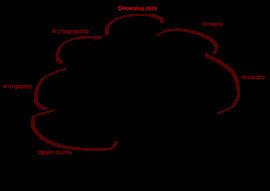Domain Eukaryota Higher classification Unikont | Scientific name Opisthokonta | |
 | ||
Lower classifications Choanoflagellate, Choanozoa | ||
The opisthokonts (Greek: ὀπίσθιος (opísthios) = "rear, posterior" + κοντός (kontós) = "pole" i.e. "flagellum") are a broad group of eukaryotes, including both the animal and fungus kingdoms, together with the eukaryotic microorganisms that are sometimes grouped in the paraphyletic phylum Choanozoa (conventionally assigned to the protist "kingdom"). The opisthokonts, sometimes referred to as the "Fungi/Metazoa group", are generally recognized as a monophyletic clade.
Contents
Paul stamets vision of paradise
Flagella
One common characteristic of opisthokonts is that flagellate cells, such as the sperm of most animals and the spores of the chytrid fungi, propel themselves with a single posterior flagellum. It is this feature that gives the group its name. In contrast, flagellate cells in other eukaryote groups propel themselves with one or more anterior flagella (see Zoospore morphological types). In some opisthokont groups, including most of the fungi, flagellate cells have been lost.
History
The close relationship between animals and fungi was suggested by Thomas Cavalier-Smith in 1987, who used the informal name opisthokonta (the formal name has been used for the chytrids by Copeland in 1956), and was supported by later genetic studies.
Early phylogenies placed fungi near the plants and other groups that have mitochondria with flat cristae, but this character varies. More recently, it has been said that holozoa (animals) and holomycota (fungi) are much more closely related to each other than either is to plants, because opisthokonts have a triple fusion of carbamoyl phosphate synthetase, dihydroorotase, and aspartate carbamoyltransferase that is not present in plants, and plants have a fusion of thymidylate synthase and dihydrofolate reductase not present in the opisthokonts. Animals and fungi are also more closely related to amoebas than they are to plants, and plants are more closely related to the SAR supergroup of protists than they are to animals or fungi.
Cavalier-Smith and Stechmann argue that the uniciliate eukaryotes such as opisthokonts and Amoebozoa, collectively called unikonts, split off from the other biciliate eukaryotes, called bikonts, shortly after they evolved.
Taxonomy
Opisthokonts are divided into Holomycota or Nucletmycea (fungi and all organisms more closely related to fungi than to animals) and Holozoa (animals and all organisms more closely related to animals than to fungi); no opisthokonts basal to the Holomycota/Holozoa split have yet been identified. However, a 2013 study suggests that there may be many more unicellular opisthokonts than previously suspected. Holomycota and Holozoa are composed of the following groups.
The paraphyletic taxon Choanozoa includes either non-animal holozoans, or non-animal, non-fungi opisthokonts.
The choanoflagellates have a circular mitochondrial DNA genome with long intergenic regions. This is four times as large as animal mitochondrial genomes and contains twice as many protein genes.
Corallochytrium seem likely to be more closely related to the fungi than to the animals on the basis of the presence of ergosterol in their membranes and being capable of synthesis of lysine via the α-aminoadipate (AAA) pathway.
The ichthyosporeans have a two amino acid deletion in their elongation factor 1 α gene that is considered characteristic of fungi.
The ichthyosl genome is >200 kilobase pairs in length and consists of several hundred linear chromosomes that share elaborate terminal-specific sequence patterns.
